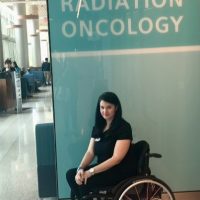Breast Cancer Awareness Month: Bridging the Screening Gap

In May 2019, I was diagnosed with breast cancer. My family physician had been urging me to get a mammogram for months and I had continuously been putting it off. “You turned 40 while you were in the hospital and now is the time for you to get a mammogram,” she kept telling me during my regular checkups. As a person recently disabled due to a spinal cord injury, I had enough of tests for a very long time…or so I thought.
My doctor kept insisting that I needed to get the mammogram done. And so, I did. They found a mass that was deemed “lobular” (which I had never heard before), and the biopsy revealed that the mass was cancer.
According to the Centers for Disease Control and Prevention (CDC), among women aged 50-74, approximately 75% of women without disabilities reported having a mammogram in the past two years, compared to only 61% of women with disabilities. Data continuously shows that women with disabilities are less likely to be up to date with mammography screening than women without disabilities. Barriers that may contribute to women with disabilities not getting properly screened include accessibility issues: physical barriers such as equipment that may not adjust for mobility-impaired women and/or mammography rooms that are not accessible; provider issues: lack of recommendation from the doctor or inability of the mammography facility to accommodate; and social determinants of health: transportation, cost, and isolation.
When I first sought out a location for my mammography, the first provider told me they could not accommodate someone in a wheelchair. “You have to be able to stand up to do the mammogram,” they told me. But I persisted and called several other providers until I found one that would happily accommodate me. My first mammogram was done from my wheelchair, and I did not, in fact, need to stand up for it.
I am forever grateful to my family doctor for pushing me to get that mammogram screening done. Early detection matters. My tumor was stage 2A and had it gone much longer, my outcome could have been much different.
When breast cancer is found early and confined to the breast, the 5-year survival rate is about 99%. Ensuring everyone has equal access to mammograms isn’t just about inclusion – it’s about saving lives. It saved mine.
A lumpectomy followed my cancer diagnosis and 6 weeks of radiation, all of which was much more complicated due to being a wheelchair user and the hospitals not being the most accessibly friendly places. But I continued to advocate for myself, vocalize my needs and work with staff to find the best and safest treatment for me.
This October, let’s raise awareness not only about breast cancer but also about the need for accessible, inclusive screening for all women. Early detection should be within everyone’s reach.













